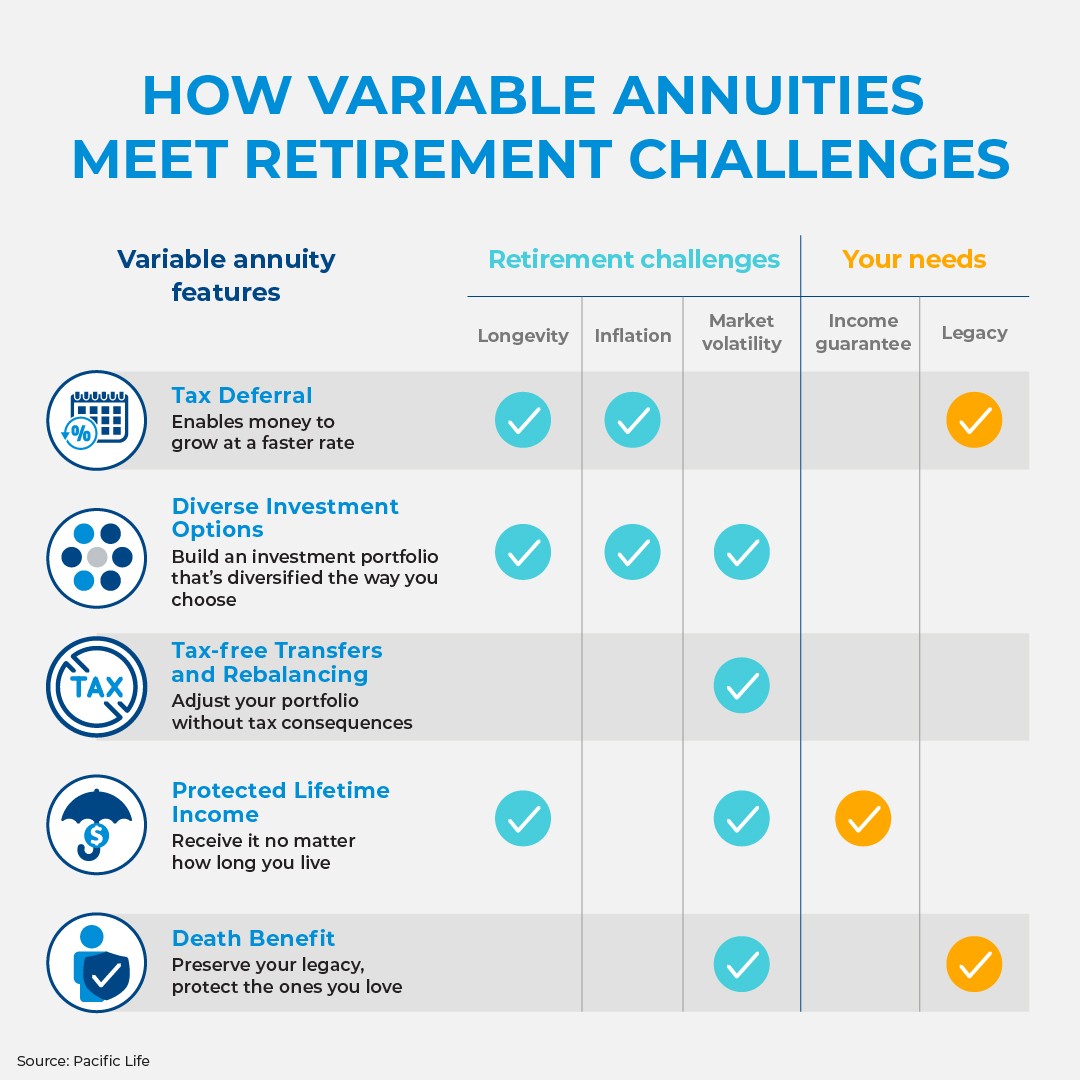All Categories
Featured
Table of Contents
Simply as with a dealt with annuity, the proprietor of a variable annuity pays an insurer a round figure or collection of repayments for the pledge of a collection of future payments in return. As mentioned over, while a repaired annuity grows at a guaranteed, consistent price, a variable annuity expands at a variable price that depends upon the performance of the underlying financial investments, called sub-accounts.

Throughout the buildup stage, possessions bought variable annuity sub-accounts grow on a tax-deferred basis and are taxed just when the agreement owner withdraws those profits from the account. After the buildup phase comes the earnings phase. With time, variable annuity properties should theoretically boost in worth till the agreement owner determines she or he would love to start taking out money from the account.
The most considerable concern that variable annuities commonly present is high price. Variable annuities have a number of layers of charges and expenditures that can, in accumulation, create a drag of up to 3-4% of the contract's worth each year.
Analyzing What Is A Variable Annuity Vs A Fixed Annuity Everything You Need to Know About Variable Vs Fixed Annuities What Is the Best Retirement Option? Pros and Cons of Various Financial Options Why Choosing the Right Financial Strategy Is Worth Considering Variable Annuity Vs Fixed Indexed Annuity: A Complete Overview Key Differences Between Immediate Fixed Annuity Vs Variable Annuity Understanding the Key Features of What Is Variable Annuity Vs Fixed Annuity Who Should Consider Strategic Financial Planning? Tips for Choosing the Best Investment Strategy FAQs About Planning Your Financial Future Common Mistakes to Avoid When Planning Your Retirement Financial Planning Simplified: Understanding What Is A Variable Annuity Vs A Fixed Annuity A Beginner’s Guide to Smart Investment Decisions A Closer Look at Retirement Income Fixed Vs Variable Annuity
M&E cost costs are determined as a percentage of the contract worth Annuity companies hand down recordkeeping and various other management costs to the contract proprietor. This can be in the type of a level yearly fee or a percent of the agreement worth. Management fees may be consisted of as part of the M&E threat fee or may be examined individually.
These costs can vary from 0.1% for passive funds to 1.5% or more for actively taken care of funds. Annuity contracts can be personalized in a variety of ways to offer the details needs of the agreement owner. Some common variable annuity motorcyclists include ensured minimal buildup advantage (GMAB), assured minimum withdrawal advantage (GMWB), and assured minimum revenue advantage (GMIB).

Variable annuity payments offer no such tax obligation deduction. Variable annuities have a tendency to be highly inefficient lorries for passing wealth to the future generation due to the fact that they do not appreciate a cost-basis adjustment when the initial agreement proprietor passes away. When the proprietor of a taxed investment account dies, the expense bases of the investments held in the account are changed to reflect the market prices of those investments at the time of the proprietor's fatality.
Breaking Down Your Investment Choices A Closer Look at What Is A Variable Annuity Vs A Fixed Annuity Defining Fixed Interest Annuity Vs Variable Investment Annuity Benefits of Fixed Vs Variable Annuity Pros And Cons Why Retirement Income Fixed Vs Variable Annuity Can Impact Your Future Annuities Fixed Vs Variable: Explained in Detail Key Differences Between Different Financial Strategies Understanding the Risks of Long-Term Investments Who Should Consider Variable Annuities Vs Fixed Annuities? Tips for Choosing the Best Investment Strategy FAQs About Planning Your Financial Future Common Mistakes to Avoid When Planning Your Retirement Financial Planning Simplified: Understanding Your Options A Beginner’s Guide to Deferred Annuity Vs Variable Annuity A Closer Look at Fixed Income Annuity Vs Variable Growth Annuity
Such is not the case with variable annuities. Investments held within a variable annuity do not obtain a cost-basis adjustment when the original owner of the annuity passes away.
One significant issue connected to variable annuities is the capacity for disputes of interest that might exist on the component of annuity salespeople. Unlike a monetary advisor, that has a fiduciary obligation to make financial investment decisions that benefit the customer, an insurance coverage broker has no such fiduciary commitment. Annuity sales are highly lucrative for the insurance policy experts that sell them as a result of high upfront sales compensations.

Lots of variable annuity contracts include language which places a cap on the percent of gain that can be experienced by particular sub-accounts. These caps stop the annuity proprietor from totally joining a part of gains that might or else be enjoyed in years in which markets generate substantial returns. From an outsider's point of view, it would certainly seem that investors are trading a cap on financial investment returns for the abovementioned guaranteed floor on financial investment returns.
As kept in mind above, surrender fees can drastically restrict an annuity proprietor's capacity to relocate properties out of an annuity in the very early years of the agreement. Further, while a lot of variable annuities permit agreement proprietors to take out a defined amount throughout the build-up stage, withdrawals yet quantity normally cause a company-imposed charge.
Withdrawals made from a fixed rate of interest price investment choice can additionally experience a "market worth adjustment" or MVA. An MVA changes the worth of the withdrawal to reflect any type of changes in rates of interest from the time that the money was purchased the fixed-rate choice to the time that it was taken out.

On a regular basis, also the salespeople that offer them do not fully comprehend how they work, and so salespeople in some cases prey on a buyer's feelings to sell variable annuities instead than the advantages and suitability of the items themselves. Our company believe that investors need to fully understand what they own and exactly how much they are paying to possess it.
Understanding Fixed Vs Variable Annuity Pros Cons A Comprehensive Guide to Investment Choices Defining the Right Financial Strategy Advantages and Disadvantages of Different Retirement Plans Why Retirement Income Fixed Vs Variable Annuity Matters for Retirement Planning How to Compare Different Investment Plans: Explained in Detail Key Differences Between Different Financial Strategies Understanding the Risks of Long-Term Investments Who Should Consider Strategic Financial Planning? Tips for Choosing Fixed Interest Annuity Vs Variable Investment Annuity FAQs About Planning Your Financial Future Common Mistakes to Avoid When Choosing Pros And Cons Of Fixed Annuity And Variable Annuity Financial Planning Simplified: Understanding Deferred Annuity Vs Variable Annuity A Beginner’s Guide to Smart Investment Decisions A Closer Look at How to Build a Retirement Plan
The very same can not be stated for variable annuity possessions held in fixed-rate financial investments. These properties legitimately belong to the insurance provider and would certainly consequently be at threat if the business were to stop working. Any type of warranties that the insurance policy company has actually agreed to offer, such as a guaranteed minimum income benefit, would be in question in the occasion of a service failing.
Potential purchasers of variable annuities should recognize and consider the monetary problem of the issuing insurance coverage company before entering right into an annuity agreement. While the advantages and disadvantages of numerous kinds of annuities can be disputed, the genuine issue bordering annuities is that of suitability. Put merely, the inquiry is: who should own a variable annuity? This inquiry can be challenging to respond to, given the myriad variants offered in the variable annuity world, however there are some fundamental standards that can help investors decide whether annuities should play a function in their economic strategies.
After all, as the stating goes: "Caveat emptor!" This article is prepared by Pekin Hardy Strauss, Inc. Benefits of annuitization. ("Pekin Hardy," dba Pekin Hardy Strauss Wide Range Management) for informational functions just and is not intended as an offer or solicitation for service. The information and information in this article does not comprise lawful, tax, bookkeeping, investment, or various other specialist recommendations
Table of Contents
Latest Posts
Analyzing Variable Annuity Vs Fixed Indexed Annuity A Comprehensive Guide to Investment Choices What Is Fixed Vs Variable Annuity? Benefits of Choosing the Right Financial Plan Why Fixed Index Annuity
Decoding Variable Vs Fixed Annuity A Closer Look at How Retirement Planning Works Defining the Right Financial Strategy Pros and Cons of Various Financial Options Why Choosing the Right Financial Stra
Analyzing Fixed Index Annuity Vs Variable Annuities Key Insights on Fixed Income Annuity Vs Variable Growth Annuity What Is the Best Retirement Option? Pros and Cons of Various Financial Options Why C
More
Latest Posts